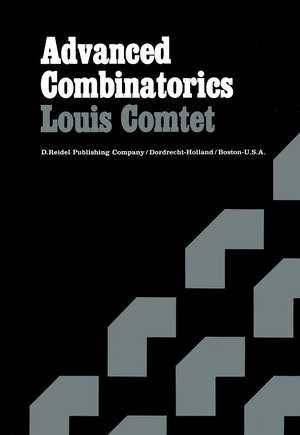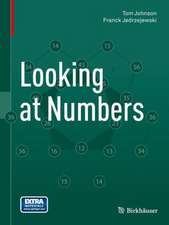Advanced Combinatorics: The Art of Finite and Infinite Expansions
Autor Louis Comteten Limba Engleză Paperback – 6 noi 2011
Preț: 778.74 lei
Preț vechi: 949.68 lei
-18% Nou
Puncte Express: 1168
Preț estimativ în valută:
149.02€ • 159.35$ • 124.24£
149.02€ • 159.35$ • 124.24£
Carte tipărită la comandă
Livrare economică 18 aprilie-02 mai
Preluare comenzi: 021 569.72.76
Specificații
ISBN-13: 9789401021982
ISBN-10: 9401021988
Pagini: 360
Ilustrații: XI, 343 p.
Dimensiuni: 155 x 235 x 22 mm
Greutate: 0.5 kg
Ediția:1974
Editura: SPRINGER NETHERLANDS
Colecția Springer
Locul publicării:Dordrecht, Netherlands
ISBN-10: 9401021988
Pagini: 360
Ilustrații: XI, 343 p.
Dimensiuni: 155 x 235 x 22 mm
Greutate: 0.5 kg
Ediția:1974
Editura: SPRINGER NETHERLANDS
Colecția Springer
Locul publicării:Dordrecht, Netherlands
Public țintă
ResearchCuprins
I. Vocabulary of Combinatorial Analysis.- 1.1. Subsets of a Set; Operations.- 1.2. Product Sets.- 1.3. Maps.- 1.4. Arrangements, Permutations.- 1.5. Combinations (without repetitions) or Blocks.- 1.6. Binomial Identity.- 1.7. Combinations with Repetitions.- 1.8. Subsets of [n], Random Walk.- 1.9. Subsets of Z/nZ.- 1.10. Divisions and Partitions of a Set; Multinomial Identity.- 1.11. Bound Variables.- 1.12. Formal Series.- 1.13. Generating Functions.- 1.14. List of the Principal Generating Functions.- 1.15. Bracketing Problems.- 1.16. Relations.- 1.17. Graphs.- 1.18. Digraphs; Functions from a Finite Set into Itself.- Supplement and Exercises.- II. Partitions of Integers.- 2.1. Definitions of Partitions of an Integer [n].- 2.2. Generating Functions of p(n) and P(n, m).- 2.3. Conditional Partitions.- 2.4. Ferrers Diagrams.- 2.5. Special Identities; ‘Formal’ and ‘Combinatorial’ Proofs.- 2.6. Partitions with Forbidden Summands; Denumerants.- Supplement and Exercises.- III. Identities and Expansions.- 3.1. Expansion of a Product of Sums; Abel Identity.- 3.2. Product of Formal Series; Leibniz Formula.- 3.3. Bell Polynomials.- 3.4. Substitution of One Formal Series into Another; Formula of Faà di Bruno.- 3.5. Logarithmic and Potential Polynomials.- 3.6. Inversion Formulas and Matrix Calculus.- 3.7. Fractionary Iterates of Formal Series.- 3.8. Inversion Formula of Lagrange.- 3.9. Finite Summation Formulas.- Supplement and Exercises.- IV. Sieve Formulas.- 4.1. Number of Elements of a Union or Intersection.- 4.2. The ‘problème des rencontres’.- 4.3. The ‘problème des ménages’.- 4.4. Boolean Algebra Generated by a System of Subsets.- 4.5. The Method of Rényi for Linear Inequalities.- 4.6. Poincaré Formula.- 4.7. Bonferroni Inequalities.- 4.8. Formulas of Ch.Jordan.- 4.9. Permanents.- Supplement and Exercises.- V. Stirling Numbers.- 5.1. Stirling Numbers of the Second Kind S(n, k) and Partitions of Sets.- 5.2. Generating Functions for S(n, k).- 5.3. Recurrence Relations between the S(n, k).- 5.4. The Number ?(n) of Partitions or Equivalence Relations of a Set with n Elements.- 5.5. Stirling Numbers of the First Kind s(n, k) and their Generating Functions.- 5.6. Recurrence Relations between the s(n, k).- 5.7. The Values of s(n, k).- 5.8. Congruence Problems.- Supplement and Exercises.- VI. Permutations.- 6.1. The Symmetric Group.- 6.2. Counting Problems Related to Decomposition in Cycles; Return to Stirling Numbers of the First Kind.- 6.3. Multipermutations.- 6.4. Inversions of a Permutation of [n].- 6.5. Permutations by Number of Rises; Eulerian Numbers.- 6.6. Groups of Permutations; Cycle Indicator Polynomial; Burnside Theorem.- 6.7. Theorem of Pólya.- Supplement and Exercises.- VII. Examples of Inequalities and Estimates.- 7.1. Convexity and Unimodality of Combinatorial Sequences.- 7.2. Sperner Systems.- 7.3. Asymptotic Study of the Number of Regular Graphs of Order Two on N.- 7.4. Random Permutations.- 7.5. Theorem of Ramsey.- 7.6. Binary (Bicolour) Ramsey Numbers.- 7.7. Squares in Relations.- Supplement and Exercises.- Fundamental Numerical Tables.- Factorials with Their Prime Factor Decomposition.- Binomial Coefficients.- Partitions of Integers.- Bell Polynomials.- Logarithmic Polynomials.- Partially Ordinary Bell polynomials.- Multinomial Coefficients.- Stirling Numbers of the First Kind.- Stirling Numbers of the Second Kind and Exponential Numbers.
















